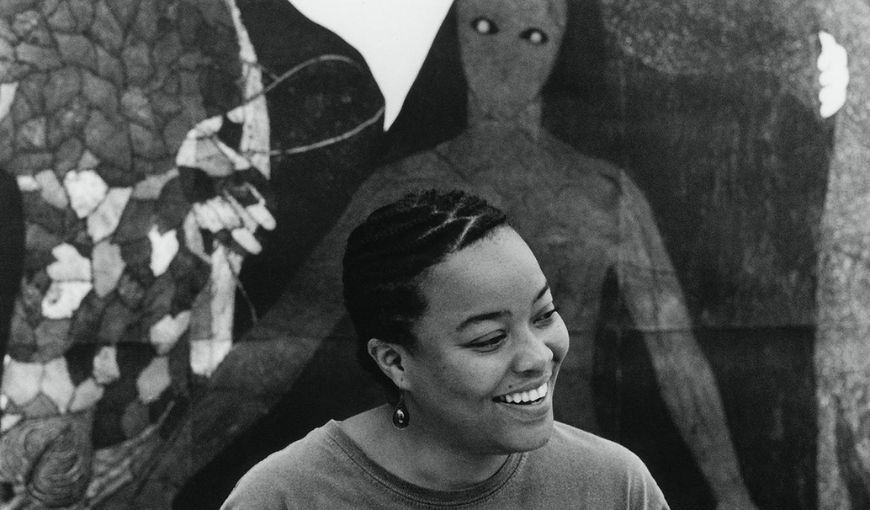Mystery enshrouds Belkis Ayon Manso’s death (Havana, 1967-1999); the same mystery that can be seen in her work, full of fascinating paradoxes: incomplete yet expressive faces, missing mouths that don’t keep quiet, art made by a woman about a secret world that only accepts men, a religious and magical world recreated within the view of an atheist spectator.
Nobody knows why this painter locked herself in the bathroom on that fateful day in 1999 and shot herself in the head. Nobody knows why she did it. But her engravings do.
Her last works were perhaps a premonition of her suicide: “darker and more dramatic, space is reduced to circles with a single face in the foreground that introduces the spectator into a universe of intense internal conflict and profound existential anguish,” reads the press release for the exhibition “Collagraphs, Belkis Ayon”, inaugurated at the Reina Sofia Museum in Madrid, on November 17th.
The exhibition includes 80 large format pieces, out of which 50 are collagraphs (almost all of which are unpublished), created between 1986 and 1999. Some of them have been displayed in the US, at the El Museo del Barrio in New York (2017), the Fowler Museum at UCLA in Los Angeles (2017) and the Station Museum of Contemporary Art in Houston (2018).
They arrived in Europe for the first time thanks to the Belkis Ayon Estate Foundation, headed by her nieces, who inherited the protection of this family and national heritage from their mother, Katia Ayon Manso (who passed in 2019).
It is also the first time that a Cuban woman’s work is being displayed at the Reina Sofia Museum, and the second time a retrospective of an artist from the island is being held, after the retrospective dedicated to Wilfredo Lam in 2016.
“The exhibition approaches the artist’s work from her first visual investigations about the secret Afro-Cuban society Abakuá, imagery that has accompanied her since the presentation of her dissertation at Havana’s San Alejandro National Academy of Fine Arts in 1988; moving towards her black and white engravings in the 1990s, as a more appropriate medium for expressing the existential drama that is seen in her work; to her large format pieces that are marked by their scenography where you travel through a complex visual and symbolic universe that syncretizes Abakuá mythology and rituals with the main iconographic elements of Catholicism,” the press release reads.
The exhibition has been curated by Cristina Vives, from the Estudio Figuero Vives, who was also a close friend of the artist and preferred to remember Ayon as a “civic Cuban woman” who “would have continued to work and navigate hardship” if she were still alive today.
Ayon’s work centers around imagery of the Abakua, a secret male society that fascinated this woman from Havana, who graduated from the University of Arts of Cuba (ISA). Her first work on the subject dates to 1985. Ayon dedicated special attention to princess Sikán, the only woman in Abakuá lore, who was sacrificed by men.
“Sikán’s prominence and the similarity between her features and that of the artist reveal a high degree of identification, as if Ayon embodies the analogous existential complexity and fate of her character,” the author’s presentation reads. She painted a series of circular pieces with irregular shapes for the last exhibition before her death. They are believed to mark a point of synthesis in her career, where the allegorical stories from the mythology about Sikán become autobiographical, influenced by the artist’s own experiences: “they reflect both Ayon and Sikan.”
She is the only internationally renowned artist up until this day with a complete series of work dedicated to this secretive religious society, which has over 30,000 followers today. Plus, as Manuel Borja Villel, director at the Reina Sofia Museum says, “Ayon has left a series of work behind that occupy an important place within the history of Cuban and international contemporary engraving.”
“Belkis’ pieces portray different abakuá ceremonies, with a feminist spirit (…). In La cena (the dinner), Sikán is sitting in the middle of the table, imitating a painting of the last dinner of Christ (…). Belkis became a reference and master of her technique,” the Mujeres Bacanas website reads.
Ayon only lived 32 years on this Earth, but she reached full artistic maturity. In her work she also depicted, in addition to the mysteries of a religion that she was banned from, “pressing issues in the 1990s: censorship, violence, intolerance, exclusion, inequality, the mechanisms of control and power structures.”
Her work is disturbing. It can stir intrigue, sadness, fear. It is also complex because of her use of collagraphy, an unusual engraving technique based on molds built like collages, which Ayon chose to do while her colleagues focused on installation art.
“The almost 200 series of ghost-like silhouettes she left when she died are being kept in a hostile climate like the Caribbean, in tailored cedarwood boxes and full of mothballs to absorb the humidity,” El Pais newspaper published in a review. “The successive exhibitions held in the US in recent years has multiplied interest in her work and the Reina Sofia is even hoping for some pieces to become a part of its permanent collection.”
Belkis Ayon’s art overwhelms you. Her figures seem to want to find something inside those who look at them, as if the painter is transcending death through their eyes, just like princess Sikan.
—–
*Reina Sofia Museum from November 12th until April 18th 2022. Sabatini Building, 3rd floor. Price: General entry costs 10 euros. Free admission: Monday to Saturday (closed Tuesdays): from 18:00 to 20:00 Sundays: from 13:30 to 14:30.
This article was translated into English from the original in Spanish.










comments
We moderate comments on this site. If you want to know more details, read our Privacy Policy
Your email address will not be published. Mandatory fields are marked with *